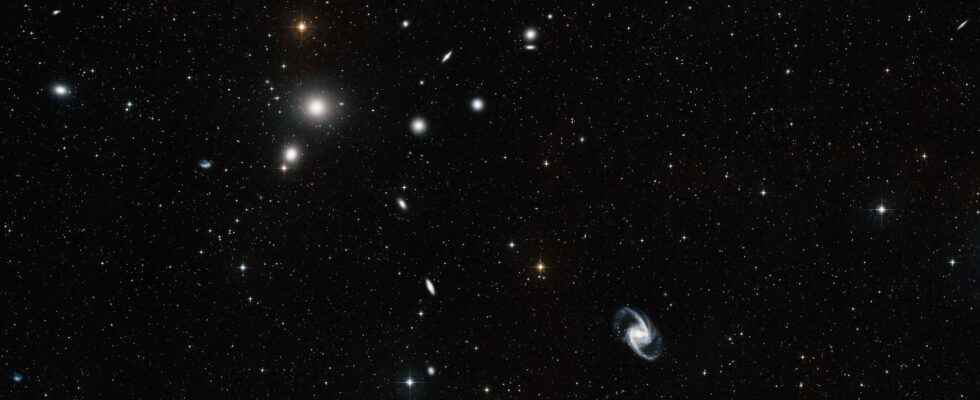You will also be interested
[EN VIDÉO] What is dark matter? Dark matter is one of the great puzzles of astrophysics. If the particles that constitute it do exist, they should allow us to understand the origin of galaxies. But their nature remains a mystery. Stefano Panebianco, research engineer at the CEA, explains this very open question to us.
Described in the 1970s to explain the rotation curve of spiral galaxies, dark matter is supposed to surround all galaxies, in the form of an invisible halo. Its existence was already suspected in the 1930s, when theastronomer Fritz Zwicky compared the mass light of galaxies, calculated from the stars which compose them, with their dynamic mass, calculated from their dispersion of the gears. This dynamic mass, which represents the gravitational influence exerted within the galaxies, was far too high compared to the luminous mass. Hence the idea of an invisible matter, called dark matter, or dark matter. According to the standard cosmological model, this matter is sensitive only to gravitation, unlike ordinary matter. This is why it has so far not been detected.
But another theory can also explain the rotation curve of spiral galaxies. Named ” Mond theory for theory of the dynamics of Newton modified, or Milgromian dynamics in honor of its inventor the physicist Mordehai Milgrom who established it in 1983, it assumes that when gravity is weak (as for stars far from the center of the galaxy), the laws of mechanics change. When astronomical observations contradict it, it adapts to them, and for the moment, it also accounts for phenomena that could testify to the presence of dark matter. And a new study published in the journal Monthly Notices of the Royal Astronomical Society and available on arXiv goes in its direction.
Dwarf galaxies in the Furnace cluster appear too distorted
astrophysicists universities of Bonn in Germany and Saint Andrews in Scotland have studied the second cluster of galaxies closest to Earth: the Fourneau cluster, or Fornax cluster. Located at 62 millionlight years from Earth, it contains 58 galaxies, which qualifies it rather as a “group of galaxies” rather than a cluster, the limit being around 100 galaxies. It houses many dwarf galaxiessmall galaxies less than 40,000 light-years in diameter and containing “few” stars compared to classic galaxies (less than a billion).
But, the particularity of this cluster lies in the shape of the dwarf galaxies it contains: these appear distorted, as if the effects of tide deformed them. Such a phenomenon is possible because the dwarf galaxies undergo the gravitational influence of their more massive companions, but the deformations observed by the researchers are too great. “Such perturbations in Furnace dwarfs are not expected according to the Standard Model”said Pavel Kroupa, co-author of the study and professor at the University of Bonn. “Indeed, according to the standard model, the dark matter halos of these dwarfs should partly protect them from the tides raised by the cluster. »
The Mond theory explains the deformations, unlike the standard model
To explain these deformations, the team decided to simulate the disturbances undergone by the dwarf galaxies, by using the two competing theories: the standard model of cosmologyand the Mond theory. “We are introducing an innovative way to test the Standard Model based on the amount of dwarf galaxies perturbed by gravitational tides from nearby larger galaxies”, said Elena Asencio, first author of the study and holder of a doctorate obtained at the University of Bonn. They then compared the results obtained with observations made by the Very Large Telescope (VLT) located in Chile.
However, Elena Asencio specifies that “ the comparison showed that, if one wants to explain the observations in the standard model, the dwarf galaxies of the Furnace should already be destroyed by gravity from the center of the cluster, even when the tides which it raises on a dwarf are sixty-four times weaker than the dwarf galaxy’s own gravity “. And this contradicts previous studies, which estimated at the equivalent ofautogravity of the galaxy the force necessary to deform it. The standard model therefore cannot explain the observed deformations, according to the researchers.
However, when the authors made a similar comparison, but this time with Milgromian dynamics, the morphology obtained by simulations and observations agreed. “We weren’t sure that dwarf galaxies would be able to survive the extreme environment of a galaxy cluster in the world, due to the lack of protective halos of dark matter in this model”said Dr Indranil Banik, study co-author and researcher at the University of St Andrews. “But our results show remarkable agreement between the observations and the Mond’s expectations for the level of disturbance of the Furnace dwarf galaxies. »
Something to question the standard model, which is still a big favorite. According to Pavel Kroupa, study co-author and researcher at the University of Bonn, “The number of publications showing incompatibilities between observations and the dark matter paradigm continues to increase each year. It’s time to start investing more resources in more promising theories.” Subsequently, the team plans to look at other dwarf galaxies or clusters of galaxies.
Interested in what you just read?
